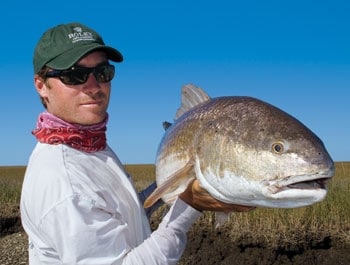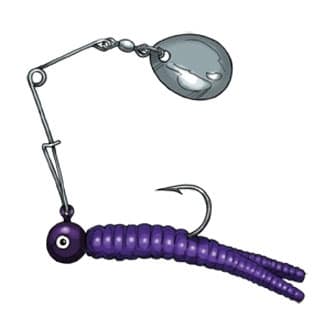
I have lived in the lower Mississippi River Delta for most of my adult life. Already a card-carrying fishing fool prior to that, I didn’t take long to realize that my new home was smack-dab in the middle of some of the best redfishing on the planet. And it didn’t take much longer for me to see that the best fishing was directly affected by the effluent of the big river’s passes. That quickly led to the realization that the tactics I had relied on in the crystalline waters of the central Texas coast were next to worthless in the Delta. Grunge demanded radically different techniques, and those I subsequently developed have since proven their worth not only there but in other areas that are plagued with turbid, or simply muddy, water.
Pop a Shrimp
I’d imagine around half of the staggering number of reds I have caught were the result of a shrimp-tipped jig suspended beneath a popping cork. That rig may sound pretty basic, but the refinements I’ve developed make it even more effective.
Custom Cork Rig: Superglue the stem into a 3-inch weighted float. Then pass a length of 40-pound mono through the center of the stem, and install a red plastic bead and a No. 3 barrel swivel on each end of the mono, which should have 2 to 3 inches of travel through the stem. The purpose of this is to prevent line twist from the shrimp-tipped jig.
To the bottom swivel, tie a 2-foot length of 20-pound nylon monofilament leader. Fluorocarbon is a good alternative but not always necessary in murky water. Next comes the jig and another refinement I have developed.
A lot of folks pop straight-up jig and soft-plastic combos for reds, and I will allow that I have caught several hundred of them thus. However, almost all of those fish were taken from reasonably clear water, where a “sweetener” was not necessary. The point is, if you add a shrimp to a jig head that is already dressed with a soft-plastic grub, the hook will lose some of its purchase.
A better option is to use a hair jig, since the fibers that make up its tail compress when the shrimp is added to it, leaving the hook gape unaffected.
Pete’s Own Hair Jig: It’s not difficult to make your own hair jigs – here’s how I make mine. Start with a quarter-ounce jig head – the round kind with a short, stout size 2/0 hook. Lash a pencil-thick 3-inch clump of DNA Fly Tying Materials Frosty Fish Fiber (or something similar) to the jig head between the round ball and the hook keeper. Voila – instant jig! And it works much better than either a bare jig head or a jig and soft-plastic combo.
The shrimp should be fairly small – the length of your little finger or thereabouts. Pop the head, insert the hook at that point, and thread the shrimp onto the hook so that the point is near the tail. Do not simply stick the hook through the shrimp from one side to the other.
Finally, work the rig with one or two fairly loud pops between pauses, which should be timed to keep it in the strike zone long enough for the fish to locate it. I should also mention that this technique accounted for both my largest inshore red (just under 16 pounds) and my best catch (73 fish) – both of which were caught in the grunge.

_Joe Mahler / _www.markerjockey.com
Spinnerbait When You Can
Late last spring, I was crawling mudbugs along the shoreline of Atchafalaya Bay with my friend Dr. Chip Metz, of Morgan City. He and another friend had recently been putting some good hits on the reds in that manner, and we were following suit.

After the sun had risen a bit, my companion noted that the water had cleared since his last trip there – not much, but a little, and after “testing” it, I discovered that it did indeed have about 6 inches of subsurface visibility. That’s still a bit grungy, but plenty clear enough to speculate with a spinnerbait, so I did and caught a red on each of my first six casts with it.
If you can’t find bait shrimp and decide to forgo the crawfish option, and if the water you intend to fish has roughly the same visibility I found that day, then in my opinion a spinnerbait is the best thing going.
Build spinnerbaits with the same quarter-ounce jig head you’d use for the aforementioned hair jig, a gold No. 4 safety-pin spinner and a purple soft-plastic grub. OK, black then – but one of those two.
The retrieve should be made entirely of slow pumps created by raising the rod to feel the spinner throb and then dropping it while quickly reeling in the slack line. This intermittent, or yo-yoing, technique will attract the fish in turbid water much better than a steady retrieve.
Like most folks, I prefer fishing for reds in clear water, but at times across much of the Gulf coast, that won’t happen – the grunge is simply a part of the annual cycle. But the fish are still there, so don’t let it defeat you. Knowing how to cope with it can lead to some surprisingly good action.
Crawl a Mudbug
Bait shrimp, even frozen ones, may not be available from midwinter to early spring, but large populations of crawfish will be, and like humans, redfish do eat crawfish!
Acquire the smaller bugs for redfish bait. Those between 3 and 3 12 inches long seem best. Buy them alive, put them in a small ice chest with a wet towel covering them, and keep them cool but not cold.
Crawfish can be rigged on a naked quarter-ounce jig head or on a fish-finder rig. I prefer the former because I have better feel with it. However, it can twist your line badly. The fish-finder rig may not prevent that entirely, but it will help.
Fish-Finder Rig: Slip an egg sinker no heavier than half an ounce and a red plastic bead onto your line, and tie it to one end of a No. 3 barrel swivel. Then tie a 2-foot length of 20-pound fluorocarbon to the swivel and the other end to a size 2/0 J hook. Do not use a Kahle-style hook, as it hooks fish too deeply for a safe release. And a circle hook doesn’t work too well because the crawfish’s hard shell back can prevent its point from penetrating the fish’s jaw.
Grasp the bug at the base of its head, and insert the hook into the bottom of its tail and out the top. And yeah, if you fish with mudbugs long enough, you will get pinched! Don’t sweat it – a crawfish can’t come close to matching a crab in the pinching department.
The crawfish should be retrieved at a snail’s pace to both prevent it from finding something to hide beneath and to cover more area. Mudbugs make a considerable racket in the water – the reason for their effectiveness – and they can pull fish from some distance. Just don’t reel them in too quickly. Maintain contact with the bait at all times, and set the hook on suspicion alone – one fish will eat the bait gently, while the next one will hammer it!

_Joe Mahler / _www.markerjockey.com









